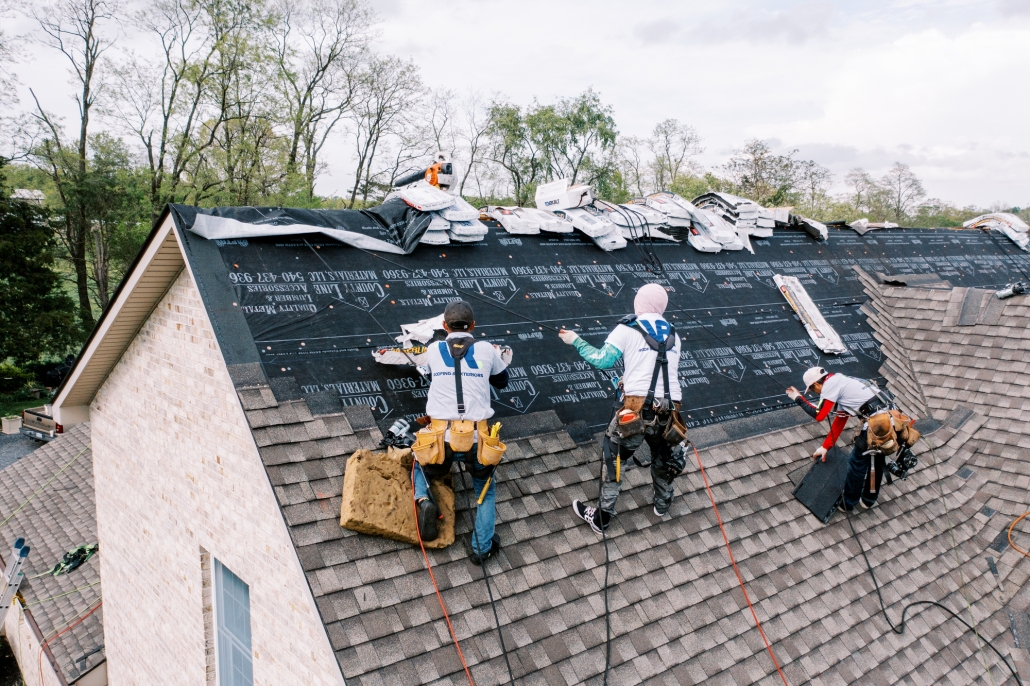Best Practices for Ensuring Appropriate Roofing Air Flow
A balanced intake and exhaust air vent ratio, generally 1:300, plays an essential role, with intake vents preferably placed at the reduced side of the roofing for cool air entrance and exhaust vents at the peak for cozy air exit. Keeping insulation away from vents is essential to avoid air flow restriction.
Understand Air Flow Basics
Properly recognizing air flow fundamentals is essential for making certain the durability and efficiency of roof systems. Reliable air flow alleviates dampness buildup and temperature level extremes in the attic, both of which can lead to significant architectural damage over time. A well-ventilated roof covering assists in stopping usual problems such as mold and mildew growth, timber rot, and ice dams, which can jeopardize the integrity of the roof covering materials and the underlying structures.
The main goal of air flow is to promote the motion of air, enabling a regular exchange in between the outside and indoor atmospheres. This equilibrium is attained via a mix of intake and exhaust vents that collaborate to preserve ideal air movement. Intake vents, generally located along the soffits or eaves, permit fresh air to go into the attic room room, while exhaust vents, usually located at or near the roof covering ridge, make it possible for warm, moist air to escape.
Key elements affecting the effectiveness of roofing air flow include appropriate positioning, appropriate sizing, and making sure that both consumption and exhaust vents are unblocked. Regular inspection and upkeep are essential to determine potential blockages, damages, or ineffectiveness in the air flow system, thus guarding the roof's performance and longevity.
Kinds Of Roofing Vents
Roof vents play a critical role in maintaining efficient attic air flow and, by expansion, the overall health and wellness of the roof system. Different kinds of roofing vents are offered, each with distinct benefits customized to details roof covering requirements.

Soffit vents are installed under the eaves and work in tandem with roof vents to make certain a balanced consumption and exhaust system. By permitting cooler air to go into from below, soffit vents assist in the expulsion of warm air through upper vents. Gable vents, located on the exterior wall surfaces of the attic, offer another effective remedy, specifically in homes with gable roof coverings.
Analyze Your Existing Ventilation

Following, think about the age and condition of your roof materials and air flow parts. Older systems might not adhere to current building ordinance or may have degraded with time, lowering their efficiency. Conduct a complete examination to determine any signs of wear and tear, such as corrosion, damage, or voids that could compromise the system's efficiency.
Additionally, determine the attic room temperature level and humidity levels. High temperature levels and humidity can indicate insufficient air flow.
Installation Best Practices
Reliable setup of roofing air flow systems is paramount for ensuring ideal efficiency and longevity. Proper installation starts with understanding the certain ventilation requirements of the roof covering and the structure it covers. This involves calculating the proper ratio of intake to wear down vents, usually adhering to the 1:300 guideline, which states one square foot of ventilation for every single 300 square feet of attic flooring space.

The positioning of vents is similarly essential. Consumption vents ought to my latest blog post be mounted at the roof's reduced edge, frequently in the soffits, to permit trendy air to enter. Exhaust vents, on the various other hand, need to be set up near or at the roofing system's top to promote the departure of warm, damp air. This produces an all-natural air flow that aids maintain temperature and dampness balance within the attic area.
Seal all vent connections carefully to stop air leaks and prospective water seepage. Use premium materials and adhere to maker standards to make certain sturdiness and performance. In addition, incorporating ridge vents with baffles can dramatically enhance air flow performance by preventing wind-driven rainfall and snow from entering the attic room.
Ultimately, accurate installment of roof air flow systems reduces potential problems such as mold growth, ice dams, and structural damages, making sure the roofing system's stability and the structure's general wellness.
Routine Upkeep Tips
Uniformity in maintenance methods is basic to making certain the lasting efficiency of roof air flow systems. Throughout these evaluations, guarantee that vents are cost-free of particles, nests, and various other blockages that could restrain air flow.
Utilize a soft brush or a vacuum cleaner to eliminate dirt and particles from intake and exhaust vents. Be careful not to damage the vent screens or louvers during the process.
Appropriate insulation is just as vital. Make sure that attic insulation does not block the vents, as this can significantly limit air movement. Reposition or replace it to preserve a reliable barrier. if any insulation has actually moved or settled.
Finally, replace any type of harmed or missing out on components without delay. Broken vents, split roof shingles, or deteriorated blinking can all add to insufficient ventilation and ought to be attended to without delay. Normal upkeep guarantees that the roof ventilation system functions optimally, therefore prolonging the life expectancy of the roof covering itself.
Final Thought
Ensuring correct roofing air flow is extremely important for preserving the efficiency and toughness of a roof system. Adherence to the 1:300 intake and exhaust air vent ratio, combined with the critical placement of vents, is vital. Routine biannual assessments, debris cleaning, and ensuring insulation does not block air movement are crucial methods. Implementing these best methods will certainly foster a well-ventilated roofing system, therefore minimizing prospective concerns associated with moisture accumulation and too check it out much heat, ultimately prolonging the roofing's life expectancy.
A well balanced consumption and exhaust vent ratio, find out this here typically 1:300, plays a critical function, with consumption vents preferably placed at the reduced edge of the roof for awesome air entry and exhaust vents at the peak for warm air exit. Intake vents, commonly located along the eaves or soffits, permit fresh air to enter the attic area, while exhaust vents, usually located at or near the roofing ridge, enable warm, damp air to run away.
Soffit vents are mounted under the eaves and job in tandem with roof covering vents to guarantee a balanced intake and exhaust system. By enabling cooler air to enter from below, soffit vents assist in the expulsion of warm air through upper vents. Adherence to the 1:300 consumption and exhaust vent ratio, coupled with the critical positioning of vents, is necessary.